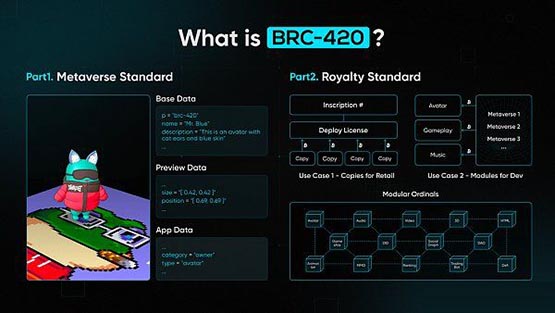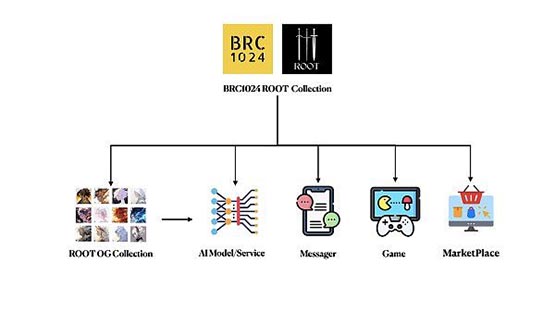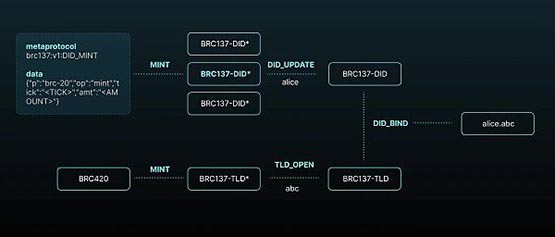php editor Xiaoxin today brings you a detailed analysis of the Bitcoin Inscription protocol. The Bitcoin Inscription Protocol is a new encryption technology that enables a more secure and private transaction process by adding additional data to Bitcoin transactions. This article will conduct a detailed inventory of both the track and the principles to help readers have a deeper understanding of the Bitcoin Inscription protocol. Whether you are a beginner or someone who already has some knowledge about Bitcoin, you will get valuable information from this article. Let’s explore the mysteries of the Bitcoin Inscription Protocol together!
The Bitcoin Inscription Protocol is one of the important technologies in the Bitcoin field, which allows Bitcoin users to publish and store data on the Bitcoin blockchain. This feature brings more application scenarios to Bitcoin and increases its value. This article will explain in detail the track and principles of the Bitcoin Inscription protocol.
Track Overview
The application scenarios of the Bitcoin Inscription protocol mainly involve two fields: data storage and data retrieval. In terms of data storage, the Inscription Protocol allows users to embed arbitrary data into Bitcoin transactions, which provides the foundation for various decentralized applications (DApps). For example, the inscription protocol can be used to implement functions such as identity authentication, decentralized storage, and the Internet of Things.
Detailed explanation of the principle
The core principle of the Inscription protocol is to utilize the OP_RETURN operation code of Bitcoin. By using OP_RETURN in Bitcoin transactions we can embed up to 80 bytes of data. This data will be permanently stored in the Bitcoin blockchain.
The Inscription Protocol works as follows:
1. The user creates a Bitcoin transaction and uses the OP_RETURN operation code in it.
2. The user attaches the data to be published to the transaction.
3. The transaction is broadcast to the Bitcoin network and packaged into blocks by miners.
4. Data is permanently stored in the blockchain.
5. Users or others can retrieve data stored in the blockchain in a specific way.
The track of Bitcoin Inscription Protocol is constantly expanding, attracting the attention of more and more developers and enterprises. From data storage to data retrieval, the Inscription Protocol brings new application scenarios and business opportunities to Bitcoin. However, there are still some challenges in this field, such as the efficiency of data retrieval and privacy issues. In the future, with the continuous advancement of technology and the continuous expansion of application scenarios, I believe these problems will also be effectively solved.
Author: Community ID
In the Inscription protocol infrastructure on the Bitcoin chain, a series of innovative protocols such as BRC-20, BRC-420, BRC-100, BRC-1024 and BRC-137 gave birth to a new era of digital assets. These protocols are driving significant change within the Bitcoin ecosystem, ranging from the BRC-20 fungible token standard to the BRC-420 Metaverse digital asset management protocol to the BRC-100 distributed computing protocol and BRC-1024 open Metaverse construction protocol, and finally to the BRC-137 decentralized identity protocol.
The emergence of these protocols not only provides more possibilities for digital assets on the Bitcoin network, but also provides new solutions for decentralized applications, social finance, game finance and other fields. Next, We will cover these protocols in detail.
BRC-20 is a token standard whose key information is inscribed in the SegWit script data of Bitcoin transactions. The protocol, created by blockchain analyst Domo in early March 2023, allows BRC-20 tokens to carry JSON data, enabling additional functions such as token deployment, minting and transfer on the Bitcoin network. The BRC-20 standard supports the creation and transfer of fungible tokens, such as Ordi and Pepe, through the Ordinals protocol.

The BRC-20 indexer is responsible for maintaining the ledger and is completely independent of Bitcoin. The indexer must accurately record every balance change to ensure the integrity of the ledger. Although the indexer's ledger accumulates over time and node load increases, the infrastructure is robust thanks to the collaborative efforts of multiple technical teams, including OKX, ensuring the reliability of BRC-20 .
The BRC-20 token introduces an innovative dimension to the Bitcoin blockchain, providing new possibilities for tokenization and decentralized applications within the BTC ecosystem. While they demonstrate wider application and flexibility within the BTC ecosystem, there are some limitations in smart contract functionality and interoperability. However, the continued development and growing interest in BRC-20 tokens demonstrates their potential to have a significant impact on the digital asset space, making Bitcoin more than just a cryptocurrency but a platform for a variety of tokenized assets and applications .
The BRC-420 protocol is an innovative approach to digital asset management in the Metaverse, providing creators with a comprehensive system to manage, share through recursion, licensing and royalties and monetize their creations.
The protocol aims to subvert the concept of digital asset creation and distribution in virtual space. Creators using BRC-420 can develop complex asset formats such as game items, animations, effects, or game modules and open these formats for community-driven enhancement and exploitation. Most importantly, BRC-420 implements a unique system that links usage rights to licensing fees, creating new revenue streams for digital assets.

Based on the inscription, BRC-420 combines usage rights and license fees through binding relationships. Individuals who own inscriptions can assign their usage rights and set prices for them. Usage rights can be understood as allowing other users to use the creator's music, models, scripts, games, etc. in a general space, or as purchasing certain privileges, such as joining the creator's organization or club.
Key features of BRC-420 include the implementation of a complex recursive digital asset format in the Metaverse, tying usage rights to royalties for the benefit of the creator. In terms of technical specifications, it supports various recursive asset formats (2D, 3D), integrates with blockchain, and facilitates automatic royalty transfers. In addition, BRC-420 enhances usability in various digital ecosystems through widespread adoption of gaming platforms and engines, while enabling immutable asset deployment and transparent blockchain-recorded transactions to protect creators and users. right.
Regarding deployment, anyone can deploy BRC-420 for the inscription they own. Deployers are the recipients of license fees. A BRC-420 can only be deployed once per inscription, meaning that once a valid BRC-420 deployment has been made to a specific inscription, further deployments will be ineffective.
In games and modular blockchains associated with Ordinals, BRC-420 offers creative possibilities for creators. Different creators can contribute various modules, allowing new creators to build on the innovations of their predecessors, thereby proliferating innovation within the Ordinals ecosystem to the benefit of all parties involved.
The BRC-100 protocol is a decentralized computing protocol based on ordinal theory, specifically used for decentralized applications on Bitcoin Layer1, such as DeFi, SocialFi and GameFi. It is defined as an extensible decentralized computing protocol that allows new features and functionality to be integrated over time.
BRC-100 introduces unique computational operations such as mint2/mint3 and burn2/burn3, each adding a layer of complexity and functionality to the protocol. mint2 and mint3 operations extend the basic issuance process by incorporating specific conditions or states. For example, mint2 can be used to issue tokens under certain conditions, usually involving updates to the application state, while mint3 allows for the issuance of tokens without affecting the circulating supply. Mint tokens, useful for specific use cases. Similarly, burn2 and burn3 extend the standard burning process. burn2 is used to burn tokens under specific conditions, usually resulting in a change of application state, while burn3 allows tokens to be converted to different states within the application without reducing the circulating supply. For example, in a lending application, after the user mortgages the token, the application can use the mint2 command to mint authentication tokens for the user.
A distinguishing feature of the BRC-100 protocol is its comprehensive set of parameters and operations that define its functionality. Key parameters include "extends", "upgradeFrom", "openAsChild" and "stoppable", each serving a specific purpose within the protocol architecture. For example, "extends" determines inheritance from other protocols, while "stoppable" indicates whether the application can be stopped.

BRC-100 proposes a modular approach for protocol and application development: inheritance and nesting, which provides a theoretical basis for the expansion of BRC-100 protocols and applications. The protocol fundamentally describes tokens with computational power and state, extending the behavior of the BRC-20 protocol. Computing capabilities and state transitions can be extended through the BRC-100 extension protocol, and all BRC-100 extension protocols are mutually compatible, meaning tokens that implement BRC-100 and its extension protocols can be used across applications. In addition, the BRC-100 protocol and its extensions can be updated and upgraded through protocol improvements. The collection of BRC-100 protocols and their extensions and improvements is called the BRC-100 protocol stack.
The BRC-100 is known for its comprehensive parameters, various operations and advanced computing capabilities. It can support protocol extensions like BRC-101 and unique computing operations, demonstrating its adaptability and innovation in dealing with the complex needs of decentralized computing.
The BRC-1024 protocol is an open metaverse construction protocol based on Bitcoin ordinal theory. It outlines the core elements of the metaverse on the Bitcoin network, such as characters, maps, and world views, and builds a virtual open world similar to Marvel and Star Wars.
Once the Metaverse component is deployed, any wallet can mint instances of it.

The sequence of actions outlined below helps deploy a component called "charactor:warrior" in the root metaverse, clearly defining the role of the warrior in this context. In the "tick" field, the hierarchical category separator is represented by ":", indicating that "warrior" is a subset of the broader category "character".
In the field of "elements", the components of the "warrior" component are expressed in dictionary form. Keys in this dictionary are related to elemental names, including race, subrace, gender, hair color, hairstyle, skin tone, clothing, accessories, weapons, and exoskeletons, for a total of ten different elements. The corresponding value for each key is an array containing candidate values for a specific element. When initiating creation of a warrior instance via a "mint" operation, a candidate value for each element needs to be carefully selected from the provided array.

After deploying the Metaverse component, any wallet will be able to mint instances of it. After minting, the holder's wallet holds a warrior character instance in the root. After transferring the inscription to another wallet, the instance will be owned by the new wallet.
In essence, various elements in the virtual world can be precisely defined by casting different metaverse components, including characters, land, environments, worldviews, etc. The founders emphasized in the white paper that the definition of Metaverse asset elements is not limited by the current format. The protocol envisions future support for multiple types, including integers, floating point numbers, strings, etc., and even more complex construction rules. Additionally, expected features include support for upgraded features, triggering higher expectations from the user community.
BRC-137 brings a new decentralized identity system to the Bitcoin ecosystem. It provides a way for organizations and communities to differentiate themselves and build brands in the Bitcoin ecosystem, provides a high degree of flexibility and liquidity, and is the cornerstone of the Bitcoin ecosystem's decentralized social networking, community governance, and SocialVerse.
For traditional decentralized identity identifiers (DID), the format usually follows . , where represents the domain to which it belongs. Reuse of names is generally not allowed within the same domain. In order to enhance the flexibility and liquidity of domain names, BRC-137 proposes a new DID combination form.
The BRC-137 protocol allows anyone to mint unique . is a semi-fungible inscription compatible with the BRC-20 protocol with a total supply of 21 million. The holder of can customize a string as a name on it (unique across the chain and on a first-come, first-served basis). Once the inscription is inscribed with the string, it becomes irreplaceable. For infrastructure or dApps integrated with the BRC-137 protocol, inscribed can be resolved directly to the address of the inscription holder.
At the same time, inscriptions can establish binding relationships with multiple. After the binding relationship is established, . can also be resolved to the owner's address. Also distributed in a decentralized manner, any organization or community can create its own brand and establish an identity system.
BRC-137 includes three assets: BRC137-DID, BRC137-TLD and BRC137-DELEGATOR. Among them, BRC137-TLD and BRC137-DELEGATOR are non-fungible tokens based on the BRC-420 protocol, while BRC137-DID is a semi-fungible token based on the BRC-20 protocol.

`BRC-137` mainly includes the following three types of assets:
`BRC137-DID` is compatible with the `BRC-20` standard Semi-fungible token. Anyone can mint `BRC137-DID` in a fully decentralized manner, and after being named, `BRC137-DID` will become a non-fungible token that can be resolved directly to the owner's address. Additionally, `BRC137-DID` can be bound to any number of `BRC137-TLD` for additional names. The introduction of `BRC137-DID` enables decentralized identity recognition in the Bitcoin ecosystem while ensuring high liquidity in terms of asset nature.
`BRC137-TLD` is a non-fungible token in the `BRC-137` protocol. The naming rules are similar to `BRC137-DID`. Once named, it cannot be changed. The holder can set the binding fee, and the holder of `BRC137-DID` can pay the binding fee to the holder of `BRC137-TLD` to bind the suffix held, thereby achieving the acquisition of community identity. The launch of `BRC137-TLD` further enriches the ecosystem of decentralized identity on the Bitcoin chain and provides a more comprehensive solution for on-chain community governance.
`BRC137-DELEGATOR` is a special asset in the `BRC-137` protocol with a limited quantity. Holders can become proxy nodes. Agent nodes can record user transactions in batches to reduce transaction costs and make profits by charging users less than transaction fees. The introduction of the `BRC137-DELEGATOR` role not only reduces the transaction costs of `BRC-137` holders, but also provides profit opportunities for `BRC137-DELEGATOR` holders and promotes the development of the `BRC-137` ecosystem .
From the generation and transmission of inscriptions to unique computing power, to the creation of open virtual worlds through `BRC-420`, and the decentralized identity of the `BRC-137` protocol Identifying systems, each protocol presents its unique technical characteristics and application areas.
This series of inscription protocols, including `BRC-420` and `BRC-137`, is not only synonymous with digital assets, it represents a new generation of basic protocols on the Bitcoin chain, serving as the basis for the blockchain The development of chain technology has paved the way. This is not only the evolution of Bitcoin as a digital currency, but also the rise of Bitcoin as a platform, providing a solid foundation for a variety of digital assets and applications.
The above is the detailed content of A detailed review of the track and principles of the Bitcoin Inscription protocol. For more information, please follow other related articles on the PHP Chinese website!